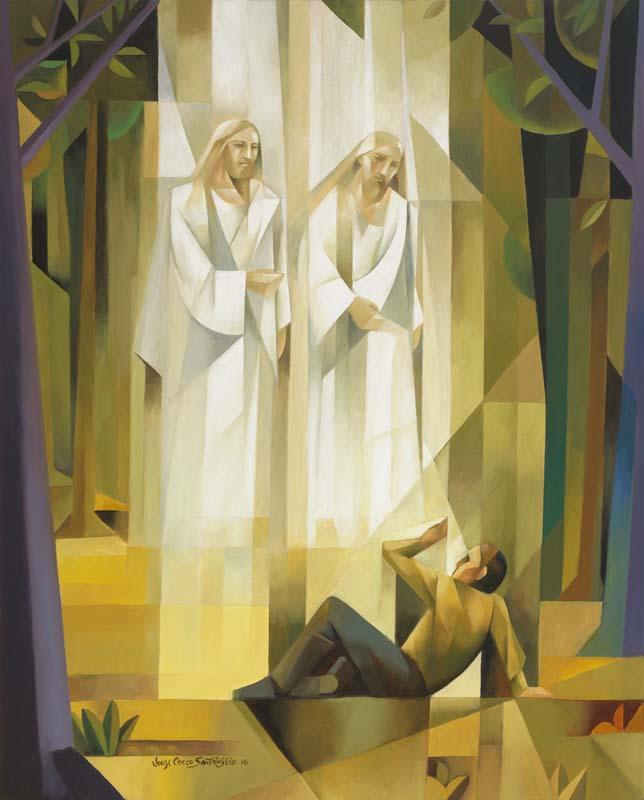You are here
The First Vision
| Title | The First Vision |
| Publication Type | Artwork |
| Year of Publication | 2016 |
| Authors | Cocco, Jorge |
| Keywords | Early Church History; First Vision; Heavenly Father; Jesus Christ; Smith, Joseph, Jr. |
| Abstract | As this piece was featured in the January 2007 Ensign, it gained quite a bit of popularity. We received hundreds of positive comments about the painting, but someone inquired to the Ensign publishers if the image was reversed or if the Father was put at the right of Jesus pointing out a scripture where it says Joseph Smith saw Jesus at the right hand of God. The following is the response of Jorge Cocco to this inquiry: This painting does not pretend to make a doctrinal or historical statement, but it tries to provide an inspirational vision through art. We have limited documentation about many details of this great event. In his retelling of this story, the young Joseph, selects and emphasizes what makes the First Vision a transcendent occurrence. "Joseph Smith did not specifically refer to the location of the characters, except that they were "standing above me in the air", and highlighted the splendor of the column of light; this gave me the freedom to pose the composition based on laws of aesthetic construction. I have also taken into account that in the history of art, the interpretation of religious themes depicted by the greatest artists varies noticeably from one another when addressing the same event. That is to say, these works are not the portrait or a copy of what happened, but a representation re-presentation, in other words "it is presented again" according to the sensitivity and the artistic motivation of each author. Our Western culture has conditioned us, both in the reading of texts and in the perception of images, to initiate the observation preferentially from top to bottom and from left to right (see the use of the capital letter which is often larger and decorated in any written material.) Precisely from the upper left corner I have moved a descending virtual diagonal from heavens to the earth positioning first the figure of the Father, who makes the pass with his hand to the hand of the Lord Jesus Christ who in turn directs our sight with his hand to the young Joseph, who is located in the lower right area. This is a suggestion of transmission of glory, authority, responsibility or power passing symbolically from the Father to the Son, and from Him to Joseph. Of course there are more codes and technicalities applied in my work which it would take a long essay to explain, and that I prefer not even to explain because at last the observer of a painting perceives them subconsciously, and because these codes and techniques are within the rules of art, and they will produce a gratifying aesthetic experience while at the same time will make the viewer recall the sacred event. This liberty of expression is what has caused the great works of art to transcend time through different generations and cultures. On the other hand, each style of art emphasizes a particular aspect of reality. In the case of this "post-cubist" series, landscape, objects and people are suggested vaguely, partly sacrificing the naturalism and putting composition, form and color as priorities. As an alternative to whoever pretends to indicate that the Son must always, unequivocally be to the right of the Father, which could well have occurred here, as we read in the scriptures “The Lord sits at the right hand of the Father” and which I consider that it is said in more of a symbolic than literal meaning, but if someone insists on it, he or she can think in their mind that the Father is placed at the left in the painting. I put no labels on the two personages since he who has seen the Son has also seen the Father because the Son is in His likeness. Anyone can see both Deities introducing themselves, dialoguing and instructing Joseph, which is really what matters. In addition, the dynamics of the work of the Gods for the salvation of humankind, surely finds Them temporarily in very different situations and places, according to the requirements of their ministry. |
| URL | https://jorgecocco.com/ |
Terms of Use
Items in the BMC Archive are made publicly available for non-commercial, private use. Inclusion within the BMC Archive does not imply endorsement. Items do not represent the official views of The Church of Jesus Christ of Latter-day Saints or of Book of Mormon Central.
Bibliographic Citation
Subscribe
Get the latest updates on Book of Mormon topics and research for free

